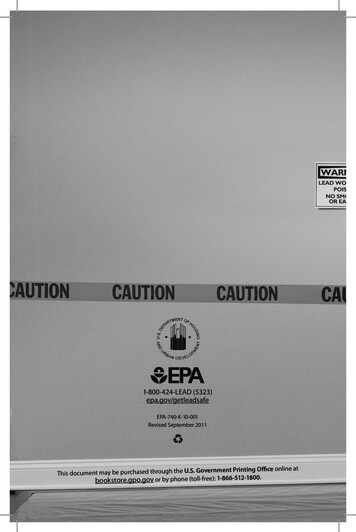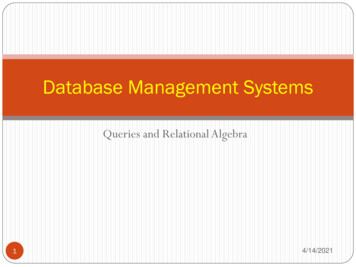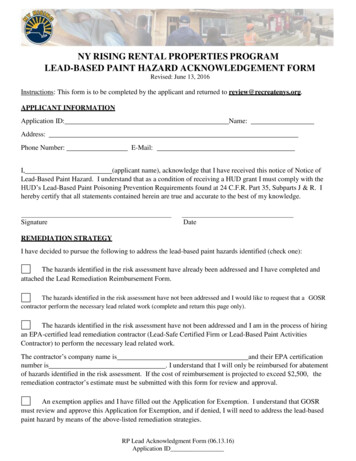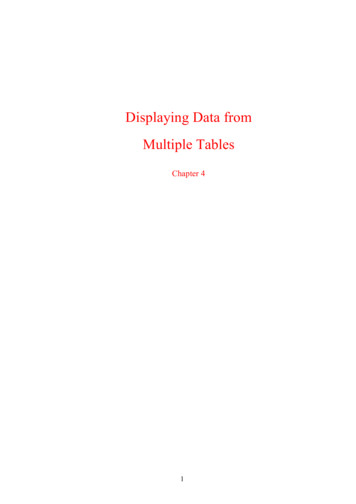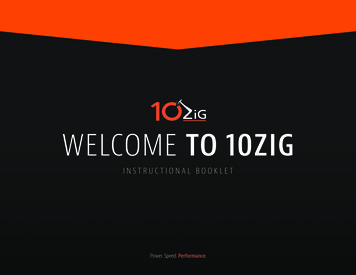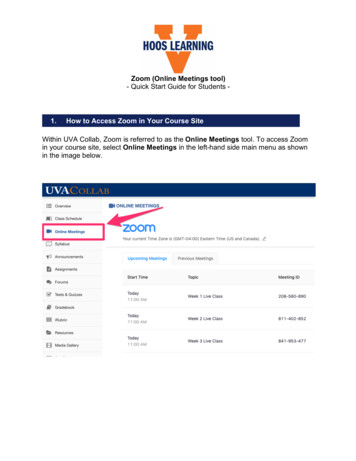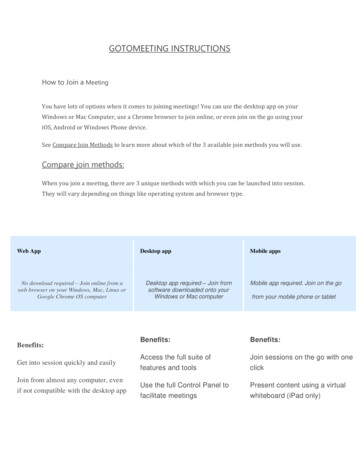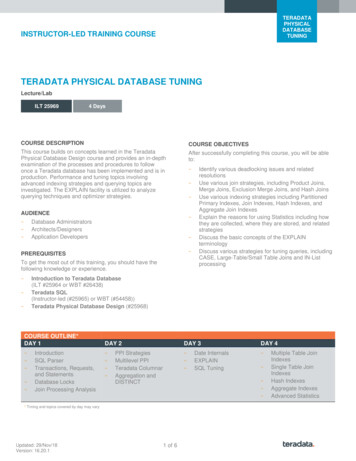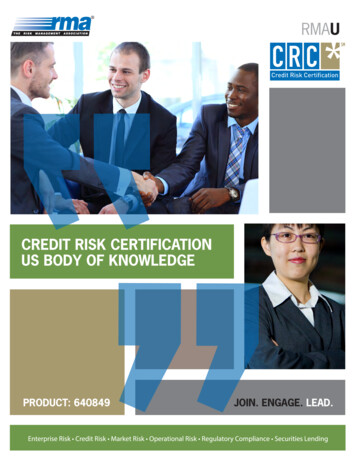
Transcription
CREDIT RISK CERTIFICATIONUS BODY OF KNOWLEDGETHE RISK MANAGEMENT ASSOCIATIONThe Risk Management Association (RMA) is a not-for-profit, member-driven professional association serving thefinancial services industry. Its sole purpose is to advance the use of sound risk principles in the financial servicesindustry. RMA promotes an enterprise approach to risk management that focuses on credit risk, market risk,operational risk, securities lending, and regulatory issues. Founded in 1914, RMA was originally called the RobertMorris Associates, named after American patriot Robert Morris, a signer of the Declaration of Independence.Morris, the principal financier of the Revolutionary War, helped establish our country’s banking system.Today, RMA has approximately 2,500 institutional members. These include banks of all sizes as well as nonbankfinancial institutions. RMA is proud of the leadership role its member institutions take in the financial servicesindustry. Relationship managers, credit officers, risk managers, and other financial services professionals in theseorganizations with responsibilities related to the risk management function represent these institutions withinRMA. Known as RMA Associates, these 16,000 individuals are located throughout North America and financialcenters in Europe, Australia and Asia.Members actively participate in the RMA network of chapters. These chapters are run by RMA Associates ona volunteer basis and they provide our members with opportunities in their local communities for education,training, and networking throughout all stages of their financial services career. Chapters are located across theU.S. and Canada as well as in financial centers internationally.RMA members also avail themselves of benefits offered through headquarters in Philadelphia, Pennsylvania.To assist members in advancing sound risk principles, RMA keeps members informed and provides access toindustry information at this site; publishes a journal (The RMA Journal) and a variety of newsletters, books, andstatistics; conducts many workshops and seminars; holds several conferences, an annual convention (Annual RiskManagement Conference); and has numerous committees working on a variety of projects.RMA welcomes all personnel involved in lending and risk management in member organizations to become RMAAssociates.Note: As a not-for-profit, professional association, RMA does not lobby on behalf of the industry.Copyright 2015 by RMA.All rights reserved. Printed in the USA No parts of this publication may be reproduced, by any technique or process whatsoever, withoutthe express written permission of the publisher.While RMA believes the material contained in this publication is accurate, the conclusions and opinions expressedare those of the authors. Moreover, no opinion expressed on a legal matter should be relied on without the adviceof counsel familiar with both the facts in a particular case and the applicable law.This material is part of RMA’s educational resources for commercial bankers at every stage of their careers. Formore information, contact the Customer Care Department, RMA, 1801 Market Street, Suite 300, Philadelphia,PA 19103. Or contact us by: Phone 800-677-7621 / Fax 215-446-4101 / E-mail courses@rmahq.org or ourwebsite: www.rmahq.org.
CREDIT RISK CERTIFICATIONUS BODY OF KNOWLEDGEBODY OF KNOWLEDGETABLE OF CONTENTSDimension 1 Evaluate Client Industry, Markets, and CompetitorDimension 2 Assessing Management’s Ability to Formulate and ExecuteBusiness and Financial StrategiesDimension 3 Complete Accurate, On-Going and Timely FinancialAssessments of the Client and its Other Credit SponsorsDimension 4 Assess Strength and Quality of Client/Sponsor Cash FlowDimension 5 Evaluate Collateral Values and Conduct Periodic Inspections ofCollateralDimension 6 Identify Repayment Sources and Appropriately Structure andDocument Credit Exposures for Their Intended Purpose (LoanStructure and Documentation)Dimension 7 Identify and Develop Strategies for Problem Loans64084902/2015
JOIN.ENGAGE.EVALUATE CLIENTINDUSTRY, MARKETS,AND COMPETITORLEAD.Dimension 1: .2Characteristics of Agribusinesses .56Purpose of Dimension 1.2Characteristics of Educational Institutions .59Additional Skill-Building Resources.2Characteristics of the Leisure/Tourism Industry.62Evaluating the Client’s Industry .3Characteristics of Nonprofit Companies .65Industry/Product Life Cycles.3Characteristics of Government Entities .68Emerging Stage .6Evaluating the Client’s Market.71Growth Stage .8Buyer/Supplier Profiles.72Mature Stage .10Buyer/Supplier Concentrations .74Declining Stage .12Buyer Concentration .74Industry Risks.14Supplier Concentration.74Macroeconomic Issues .15Entry/Exit Costs .75Cyclicality .18Vulnerability to Substitutes .76Seasonality .20Evaluating Competition in the Client’s Market.76Technology Risks .23Profiling Market Competitors.77Life Cycle Stage .23Putting Competition in the Context of the Market.78International Considerations .24Business Process and Product Risks.25Characteristics of Key Industry Sectors.35Characteristics of Manufacturing Companies.36Characteristics of Wholesaling Companies.41Characteristics of Retailing Companies .45Characteristics of Service Companies .49Characteristics of Construction Companies.52CRC US Body of Knowledge // Dimension 1 // Evaluate Client Industry, Markets, and CompetitorDIMENSION 1
DIMENSION 1 - 2NOTES:PURPOSE OF DIMENSION 1The purpose of Dimension 1 is to provide tools and insights to supportevaluation of a client’s industry, markets, and competitors.Key topics in this Dimension are: Evaluating the client’s Industry. Industry/product life cycles. Industry risks Characteristics of key industry sectors. Evaluating the client’s market. Buyer/supplier profiles. Buyer/supplier concentrations. Entry/exit costs. Vulnerability to substitution. Evaluating competition in the client’s market. Profiling market competitors. Putting competition in the context of the market.CRC US Body of KnowledgeADDITIONAL SKILL-BUILDINGRESOURCESThe material in the Body of Knowledge provides an overview ofknowledge related to topics covered by the Credit Risk Certificationexam. Mastery of topics reviewed here is essential preparation for theexam, but no amount of reading and study can substitute for lendingskills that must be acquired through formal classroom and on-the-jobtraining. In addition to reviewing the Body of Knowledge, considertaking the following RMA courses to support your Dimension 1 skillbuilding: Analyzing Industry, Business, and Management Risks Uniform Credit Analysis
DIMENSION 1 - 3EVALUATING THE CLIENT’SINDUSTRYNOTES:Understanding the industry within which a company operates is key tounderstanding the total risk in lending to that company. The objectiveof this section of Dimension 1 is to provide insights to help youanswer the question: “Does the company have a business strategy thatmakes sense within the context of general industry characteristics andeconomic trends?”The three topics included in this discussion are: Industry/product life cycles. Industry risks Characteristics of key industry sectors.In addition to general industry characteristics, businesses are affected byindustry and product life cycles. Industries, companies, and productsall have life cycles that are determined by their acceptance in themarketplace. Over time, sales for a successful product will grow, thenlevel off, and eventually decline. You can recognize stages of product lifecycles in the sales of such diverse products as light pickup trucks andminivans, personal computers, toys, and cassette tapes.Product life cycles are influenced by demand for a product (howeverderived) and by the elasticity or inelasticity of that demand. Demandis simply defined as the need or desire for the sellers’ goods andservices. Inelastic demand occurs when price is of little concern to thecustomer; therefore, a change in price has little effect on the demandfor the product. When demand is elastic, a change in price resultsin a proportionate change in the quantity of the product or servicedemanded.As products and services mature, they tend to become more pricesensitive (demand becomes more elastic). This flattening of the demandcurve is part of the natural life cycle of a product and another way tounderstand the profit decline for mature-stage products, companies, orindustries.The same product life cycle concept of emerging, growth, maturity, anddecline can be applied to businesses and entire industries.Dimension 1 // Evaluate Client Industry, Markets, and CompetitorINDUSTRY/PRODUCT LIFE CYCLES
DIMENSION 1 - 4NOTES:When evaluating companies, you should remember that: Optimistic sales and profit projections may not materialize from acompany whose products or industry are in the growth stage becausenew competitors may be able to rapidly and inexpensively enter themarket. When a company has diversified to the point at which it hasmultiple products and services, it is prudent to analyze each productline’s life cycle stage before underwriting and documenting a loan. When a company’s success depends on a single product or service,understanding its life cycle is critical to how you structure arepayment schedule before sales and cash flows are reduced orexhausted. Inelastic demand can be an advantage because the company is ableto more easily raise prices to cover costs and create more profits.In many cases, inelastic demand does not last long because of anincrease in competition or a sudden decrease in demand, or becausea substitute for the product or service has been created.In this discussion, we will cover the following life cycle stages:EMERGING STAGETotal sales are very low, consumer acceptability is uncertain, and cashflow is probably not sufficient to cover start-up costs and the fixed costsof production or providing the service.GROWTH STAGECRC US Body of KnowledgeIf the product has gained market acceptance, sales build rapidly andprofits can be very attractive, until other competitors enter the market.
DIMENSION 1 - 5MATURE STAGEProfitability peaks, flattens out, and then begins to decline becauseother companies have successfully entered the market. One company’searly success in a market is often due to its dominant market share,which may be reinforced and sustained by a patent, copyright, or secretformula. Competitors are attracted by the sales and profit success ofearly entrants and the success of these new competitors is related toease of entry into the market. Competition tends to drive prices down,especially if demand for the product at higher price levels has beensatisfied.NOTES:DECLINING STAGEDimension 1 // Evaluate Client Industry, Markets, and CompetitorConsumer demand for the product declines and sales fall. Profitsfall when sales can no longer cover the fixed costs or the companylowers prices in an attempt to maintain sales levels. However, there aresubstantial profit opportunities in this stage for a limited number ofwell-managed companies selling to a reduced, but stable, customer base.
DIMENSION 1 - 6NOTES:EMERGING STAGECompanies in the introductory or emerging stage often need largeamounts of capital to sustain them through long periods of research,product development, and test marketing. After the product has beendeveloped, test marketed, and is ready for rollout, additional fundsare needed to support advertising and marketing expenses in orderto educate the consumer and gain market acceptance. Because of theuncertainty of success, company owners and venture capitalists usuallysupply such capital. This is especially true in companies with one orjust a few products, all of which are at the same stage of development.In addition, emerging companies generally possess entrepreneurialmanagement and may lack experienced management in all of the corecompetencies needed to operate a company.Financial products and services required by companies in the emergingstage include: Equity type financing (venture capital, private placement, etc.) dueto the high cash needs and limited demonstrated debt repaymentability. Subordinated debt, preferred or common stock, or other sources oflong-term capital. For very small businesses, the owners’ personal borrowings (such ashome equity loans) may provide adequate initial long-term capital.CRC US Body of Knowledge Typical liabilities found on the emerging company’s balance sheetinclude accrued expenses, accounts payable, lines of credit (generallyif guaranteed by a sponsor) and perhaps real estate loans (withsponsor support).
Dimension 1 - 7The following chart summarizes the strengths of an industry or product in the emerging stage, along with some ofthe relevant risks.EMERGING STAGE CHARACTERISTICSEmerging:Products are developedand presented to potentialconsumers. It is uncertainat this point if there willbe acceptance of the newproduct/industry.POSSIBLE STRENGTHS High sales due to product introduction andunique positioning. Little competition High prices and grossmargins (as result oflittle competition). Registration of patentsand intellectual propertyrights to create barriersof entry to competitors. Able to develop brandloyalty.RISKS Failure: The failurerate for new productsis high—some gainacceptance only aftermodification from theiroriginal form. Production capacity:either under or overcapacity as demandvaries substantially fromprojections. Low net margins becauseof high R&D and marketing costs. Initial mismatch of cashflows. Initial product qualitymay be poor dictatingthe need for expensivechanges to the productdesign or formulation. Winning marketingstrategy prior to implementation not apparent.Dimension 1 // Evaluate Client Industry, Markets, and CompetitorLIFE CYCLE STAGE
Dimension 1 - 8NOTES:GROWTH STAGECompanies with products in the growth stage may show rapid salesgrowth and strong profitability. Often companies project that thisgrowth and profitability will continue and commit to major productionexpansions, only to find that they have shrinking sales or lower profitsor both. At the outset of the growth stage, demand may allow forcreation of additional capacity and competitors. But as the industry’ssales begin to grow at a slower rate and then peak along with increasedcompetition, only the strongest companies survive. Lending to growthstage companies requires very careful judgment of the critical factorsthat will help the company succeed over its competition and howmanagement will meet these competitive challenges.Financial products and services required by companies in the growthstage may include: Cash Management services. Revolving lines of credit to finance growing working capital assets. Long-term debt to finance fixed asset growth associated withincreased production capacity. Export financing if international in nature.CRC CRC US Body of Knowledge Mortgage loans to finance real estate needs.
Dimension 1 - 9The following chart summarizes the strengths of an industry or product in the growth stage, along with some ofthe relevant risks.LIFE CYCLE STAGEGrowth:The industry/product gainsacceptance, demand grows,and competitors enter themarket.POSSIBLE STRENGTHSRISKS Increasing demand andhigh selling prices asproduct acceptance leadsto growth in demand. Increasing competition,depending upon the costof entry. Product qualityimproved as a result ofchanges made in theemerging stage. Optimistic sales andprofit projections maynot materialize becausenew competitors enterthe market. Higher net margins thancompetitors still in theemerging stage. Production overcapacity due to increasedcompetition. Expansion andsolidification ofsignificant brand loyalty. High marketing costsrelating to increasingmarket share andproduct differentiationstrategies. Development ofcompatible productswith high margins. Sales may outstripcompany’s capital base,putting additionalrequirements on externalfunding sources.Dimension 1 // Evaluate Client Industry, Markets, and CompetitorGROWTH STAGE CHARACTERISTICS
Dimension 1 - 10NOTES:MATURE STAGECompanies in mature industries or with mature products/services mayultimately have lower gross profit margins than they enjoyed in thegrowth stage but, because of stable demand, their cash flow for debtservice may be stronger and their likelihood for continued success ismore predictable. They have weathered the trials of tough competitionand are marketing proven products or services. Mature-stage companiesare usually less risky loan candidates, especially those requiring shorterterm credit facilities.Financial products and services required by companies in the maturestage may include: Cash management services. Revolving lines of credit to finance working capital assets. Long-term fixed asset financing for equipment and other capitalexpenditures. Export financing if international in nature.CRC CRC US Body of Knowledge Mortgage loans to finance real estate needs.
Dimension 1 - 11The following chart summarizes the strengths of an industry or product in the mature stage, along with some ofthe relevant risks.MATURE STAGE CHARACTERISTICSMature:Competitors have enteredthe market and corporate efficiency has sortedout companies unable tosurvive.POSSIBLE STRENGTHS Price stability at somelevel. Superior quality Maximum brand/product loyalty achieved. Product enhancements(real or perceived)developed to extendproduct life.RISKS Declining profits causedby:–– Demand levelsoff and beginsslow decline,leading to marketshare contractionfor existingcompanies.–– A few low costproducers enterthe market.–– Competitionis maximized;products beginto become moreprice sensitiveand demandmore elasticity,forcing companiesto lower sellingprices. Production overcapacity likely; OEM’s(original equipmentmanufacturers) likely toinvade after-market inorder to use idle plantcapacity.Dimension 1 // Evaluate Client Industry, Markets, and CompetitorLIFE CYCLE STAGE
DIMENSION 1 - 12NOTES:DECLINING STAGECompanies in declining industries or with declining products may stillbe suitable borrowers, particularly for seasonal or short-term loans notdependent on long-term economic success. Companies in the decliningstage have either failed to develop new products or lines of business, orthey are in industries in which the demand for the product or service isin absolute decline. Sometimes the demand for the product or service isfading very rapidly or so gradually that it is difficult to notice.Financial products and services required by companies in the decliningstage may include: Cash management services. Revolving lines of credit to finance working capital assets. Long-term debt to finance fixed asset repair or replacement. Export financing, if international in nature. Mortgage loans to finance real estate needs.CRC US Body of Knowledge Trust services.
Dimension 1 - 13The following chart summarizes the strengths and risks of an industry or product in the declining stageDECLINING STAGE CHARACTERISTICSDecline:Sales drop as demand falls.Unless innovation occurs,the industry will shrinkand perhaps ultimately fail.POSSIBLE STRENGTHS Low advertising costs asindustry/product is fullyaccepted. Weak competitorseliminated; no longerable or willing tocompete. If demand for productdiminishes greatly, butdoes not disappear,remaining companiescan compete effectivelyin a smaller overallmarket.RISKS Lower sales Cost control disciplinerequired in orderto maintain a grossmargin contribution tooverhead. Substantial over-capacityas demand declines. Lowering margins untilproduction capacityis reduced to level ofdiminished demand. Product qualitydeteriorates due tocost cutting in themanufacturing processin order to maintaingross margin. Unable to find skilledlabor force to continuemanufacturing process.Dimension 1 // Evaluate Client Industry, Markets, and CompetitorLIFE CYCLE STAGE
DIMENSION 1 - 14NOTES:INDUSTRY RISKSDifferent industries have very specific risks, but they are also subjectto generic risks that affect all industries, albeit in different ways. Inthis section, we will analyze the risks that each company faces withinthe context of its industry and business strategy. We will examine thefollowing issues:MACROECONOMIC ISSUESThe extent to which an industry is affected by regulatory, economic,political, and public events, and labor and environmental issues.CYCLICALITYThe extent to which an industry is affected by economic or businesscycles.SEASONALITYThe extent to which an industry is affected by normal changes inclimate or calendar specific buying patterns.TECHNOLOGY RISKSThe extent to which technology has improved people/productionefficiencies, but also has created new types of risk.LIFE CYCLE STAGECRC US Body of KnowledgeThe extent to which the industry is affected by its stage in the life cycle.INTERNATIONAL CONSIDERATIONSThe extent to which this industry is affected by international events.BUSINESS PROCESS AND PRODUCT RISKSThe extent to which industry characteristics influence a customer’sbusiness processes, practices, and products.
DIMENSION 1 - 15MACROECONOMIC ISSUESNOTES:Most companies face many of these macroeconomic issues at one timeor another during their life cycle.Your customer’s financial statement reflect the direct and indirectimpact of these macroeconomic issues. You should discuss thesemacroeconomic issues with management and examine them for existingor potential problems that could impact their repayment ability.REGULATIONSAll companies face regulatory guidelines. Find out which regulationsaffect your customer and how they impact the company’s financialperformance.In assessing the financial effect of regulations, know the cost ofcompliance and risk of noncompliance. Fines associated with “out-ofcompliance-conditions” or outright noncompliance can be significant.ENVIRONMENTAL REGULATIONSAll companies face the impact of this particular group of regulations.At some point in the supply chain for the production of aproduct, environmental costs will be felt. You need to assess whichenvironmental regulations directly affect your customer.The liability for clean-up costs and fines for noncompliance could alterthe financial health of your customer. Most financial institutions requirea review of the environmental regulations that affect specific customersat origination and during the life of the transaction.Additionally, most loan documentation requires an environmentalcertificate signed by an officer of the company attesting to the firm’scompliance with applicable environmental regulations. In some cases,your institution, as a lender to the company, can become liable forenvironmental infractions. You should enlist legal and environmentalexpert assistance when documenting a loan to a company with knownor perceived environmental problems.Dimension 1 // Evaluate Client Industry, Markets, and CompetitorRegulations that require initial licensing and ongoing recertificationscan raise the cost of doing business.
DIMENSION 1 - 16NOTES:CHANGING INTEREST RATESAll companies are affected by changes in interest rates, if not directlythen through their effect on customers and suppliers. Interest rates canraise or lower operating expenses, and, as a result, raise or lower profits.Doing a mental calculation using total interest expense and interestrates (or blended rates), you can determine approximate averageprincipal amount of debt outstanding during the accounting periodand compare that number to the ending period debt balance. Thiscomparison will allow you to estimate a company’s interim periodborrowing requirements.LABORCompanies face challenges in attracting qualified people while at thesame time maintaining product or service quality.There has been a big change in how people work (flex-hours, jobsharing, etc.) and what they expect from their employers. The issuesthat employers face from labor laws, changes in work ethics, laborunion contracts, and essential skill shortages can be expensive andfraught with potential liability.POLITICAL AND PUBLIC OPINIONSome companies may escape this issue, only because they, for onereason or another, do not appear on the radar screen of some politicalbody or public advocacy group. The problem with this area is thatvery often your customer does not control the impact or timing of itsexposure to these issues.CRC US Body of KnowledgeWhile issues in this category can be expensive in terms of settlements,sometimes the larger problem becomes the disruption in the executionof the day-to-day business plan and the allocation of people andfinancial resources.These issues often arise when your customer wants to expand theirbusiness and they must get variances from code in the case of real estateor approval from existing labor pools before moving ahead. All of thesegroups have “agendas” that can be far different from the operatingstrategy of your customer.
DIMENSION 1 - 17WEATHERAs an economic force, weather becomes apparent many times only inthe form of a catastrophe such as a drought, hurricane, blizzard, hardfreezes, fire, disease, etc. Unfortunately, with the movement to “mega”businesses as companies consolidate, if a natural disaster strikes at justthe right place, it can be devastating to your customer. The disasterdoesn’t even have to have a direct effect on your client, but only has toaffect one company in the supply chain for problems to occur.NOTES:Some of these weather issues, such as business disruption, and fixedasset replacement, can be insured against. However many of theconsequences from such a disaster can permanently affect the futureviability of your customer, especially if a significant time disruptionoccurs in the production cycle.With the worldwide economy firmly in place, there is the potential forsubstantial changes in currency valuations. The risk is more than theextreme event of a country’s unexpected currency devaluation. The riskis that day-to-day volatility in the world currency markets can affect theprofitability and potential repayment ability of your customer, if notproperly hedged.Not only is there the currency risk, but if inexperienced financialmanagers address the risk, the risk can be compounded considerably. Ifyour customer is dealing directly with international clients, it is prudentfor you to assess their ability to manage their foreign currency risk; anopportunity may exist for your institution’s international department!Dimension 1 // Evaluate Client Industry, Markets, and CompetitorCURRENCY FLUCTUATIONS
DIMENSION 1 - 18NOTES:CYCLICALITYCyclicality refers to the extent to which an industry is affected by theexpansion and contraction in economic cycles, often referred to asbusiness cycles. There is much debate as to whether business cycles arerepeatable with similar economic dynamics. Economists agree that thereare often similarities between business cycles and what instigates change,but they also agree that each business cycle has its own set of economictraits. Defining the business cycle is not easy in today’s economy.As a lender, you should understand the principles of expansion andcontraction in the market place and how these movements affect yourcustomer. You should investigate your customer’s strategic approach tocounter-cyclicality, i.e., having products and services that are marketedto the other side of the business cycle. This is an especially importantconcept to grasp when considering long-term loans to fund expansionor fixed asset replacements.While economists disagree on the definition and early warningsignals for the onset of a change in the business cycle, it is best foryou to talk with your customer and other companies in a particularindustry. Management of these firms, and their industry associations,often have an ear to the ground and know what is happening in themarketplace and where the industry stands in the business cycle. Usingan intellectual barometer for business cycle movement is sometimes notas meaningful as talking with people who have an intimate and historicknowledge of the industry and vision as to how the past can be used toforecast the future for the industry.EVALUATING CYCLICALITY RISKCRC US Body of KnowledgeEvaluating the risk that cyclicality poses to a particular business involvesassessing: How vulnerable the company and its industry are to a business cycle,i.e., changes in the economy into which the company markets itsproducts or services. Not all industries react the same way or at thesame time to changes in the continuum of economic cycles. Howhave the company
Today, RMA has approximately 2,500 institutional members. ese include banks of all sizes as well as nonbank nancial institutions. RMA is proud of the leadership role its member institutions take in the nancial services industry. Relationship managers, credit o cers, risk managers, and other nancial services professionals in these
